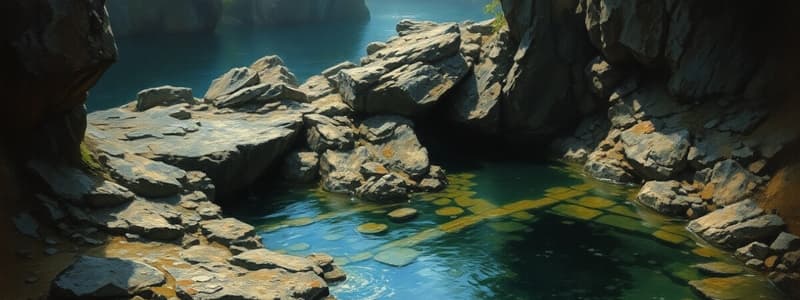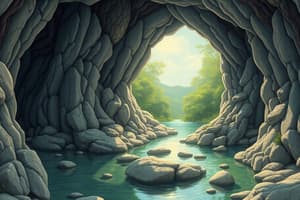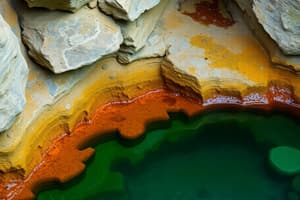Podcast
Questions and Answers
Why is surface water generally considered unsafe for drinking without treatment?
Why is surface water generally considered unsafe for drinking without treatment?
- Surface water only contains minerals that are harmful in high concentrations.
- Surface water is typically too pure and lacks essential minerals necessary for human health.
- Surface water may contain bugs, dirt, rocks, minerals, and/or chemicals from the surrounding environment. (correct)
- Surface water is sourced from underground aquifers which often have high salinity.
What factors can affect the amount of water flowing from a natural spring?
What factors can affect the amount of water flowing from a natural spring?
- The flow of springs is constant and unaffected by external factors.
- Only rainfall and human water usage affect spring flow.
- Only the water pressure within the aquifer affects spring flow.
- Water pressure in the aquifer, rainfall, and human water usage all affect spring flow. (correct)
Which of the following best describes the significance of rock holes to Aboriginal people living in arid Australia?
Which of the following best describes the significance of rock holes to Aboriginal people living in arid Australia?
- Rock holes are mainly of spiritual significance and not used for practical purposes.
- Rock holes are important for recreational activities and tourism.
- Rock holes provide a crucial water supply in dry landscapes, assisting travel and resource access. (correct)
- Rock holes are primarily used for agricultural irrigation.
A river is in its upper course; what characteristics would you expect it to have?
A river is in its upper course; what characteristics would you expect it to have?
Why might water collected in rainwater tanks not be safe to drink without treatment, even though it originates from precipitation?
Why might water collected in rainwater tanks not be safe to drink without treatment, even though it originates from precipitation?
Which of the following best describes a key difference between the middle and lower courses of a river?
Which of the following best describes a key difference between the middle and lower courses of a river?
How does erosion and deposition contribute to the formation of oxbow lakes?
How does erosion and deposition contribute to the formation of oxbow lakes?
What is the primary reason rivers do not flow in straight lines?
What is the primary reason rivers do not flow in straight lines?
In what way does the speed of a river affect its capacity for erosion and deposition?
In what way does the speed of a river affect its capacity for erosion and deposition?
How do sediments carried by a river alter the color of water bodies such as lakes and oceans?
How do sediments carried by a river alter the color of water bodies such as lakes and oceans?
Flashcards
Surface Water
Surface Water
Water found on the Earth's surface, like in lakes or rivers. It's often unsafe to drink without treatment.
Rainwater Tank
Rainwater Tank
Water collected from rainfall. While good for gardens and washing, it might have contaminants from roofs or gutters.
Spring
Spring
A natural place where groundwater flows onto the surface. Water is usually clear but can be discolored.
River
River
Signup and view all the flashcards
Confluence
Confluence
Signup and view all the flashcards
River's Upper Course
River's Upper Course
Signup and view all the flashcards
River's Middle Course
River's Middle Course
Signup and view all the flashcards
River's Lower Course
River's Lower Course
Signup and view all the flashcards
Erosion
Erosion
Signup and view all the flashcards
Deposition
Deposition
Signup and view all the flashcards
Study Notes
- Surface water is unsafe to drink because it may contain bugs, dirt, rocks, minerals, and/or chemicals.
- Animals may drink and bathe in surface water sources, potentially causing contamination.
- Rainwater tanks collect and conserve water but may contain contaminants from the roof or gutters.
- Rainwater from tanks is suitable for watering gardens and washing cars/clothes.
- If tank water is for drinking, gutters must be cleaned to avoid contamination.
- Waterholes, rock holes and springs provide water from a combination of ground and surface sources.
Rock Holes
- These are surface water features where water is held in a rock or rocky area.
- They are valuable to Aboriginal people in arid Australia.
- Rock holes are a crucial water supply in dry landscapes with little permanent surface water.
- They assist with travel and access to a larger range of resources.
Springs
- Springs occur when water from an underground aquifer comes to the surface.
- The flow rate is affected by water pressure in the aquifer, rainfall, and human usage.
- Spring water is usually clear but can be discolored by minerals in the ground.
Rivers
- Rivers are large natural streams of water flowing over land, essential to human civilization.
- Rivers transport freshwater to people, plants, and animals worldwide.
- They provide transport, water power, and shape the land by carving valleys and canyons.
River Stages
The Upper Course
- Rain in highland areas collects in channels, forming a stream.
- Streams join others, increasing in size and speed.
- A confluence is where two rivers join.
- The river flows rapidly, cuts through the land, and picks up soil and gravel.
- Over time, the river creates canyons and deep valleys.
The Middle Course
- Fast-flowing water causes erosion, making the river deeper and wider.
- The river erodes left and right, forming meanders.
- As the river flows down gentler slopes, it gets larger and slower.
- Soil, gravel, and sand sink to the bottom.
- Sandbars and islands form from accumulated material.
The Lower Course
- The river flows slowly in flatland.
- There’s less water force than in other stages.
- The river drops eroded sediment.
- The river flows even more slowly, dropping more solid material.
- Deltas form as material accumulates where the river enters the sea.
Erosion and Deposition
- Rivers don't travel in straight lines to avoid obstacles and because humans alter them.
- Erosion and deposition change the shape of a river.
- Erosion involves moving materials like soil or rocks by wind or water, known as sediments.
- Deposition is when sediments are dropped off in a new location.
- Moving waters pick up sand, dirt, and other sediments and carry them downstream.
- Rivers turn brown or murky from the materials they carry.
- Sediments are deposited into lakes or oceans at the end of the river.
Meanders
- These can grow until the water erodes away so much of the river's banks that two meanders merge together.
- The water then takes a new, shorter route.
- Over time, deposition of the river's load will block off the old part of the river, forming an oxbow lake.
Studying That Suits You
Use AI to generate personalized quizzes and flashcards to suit your learning preferences.




